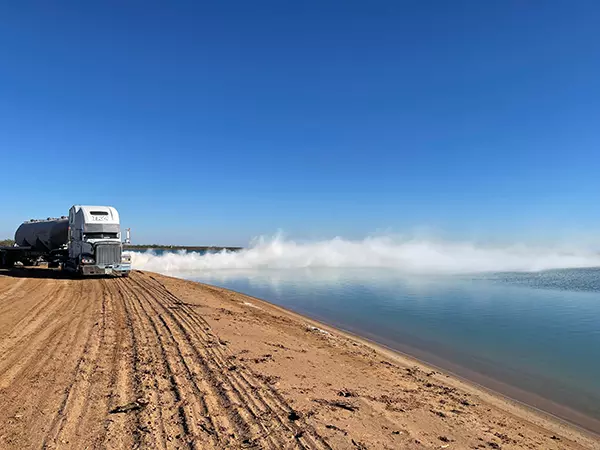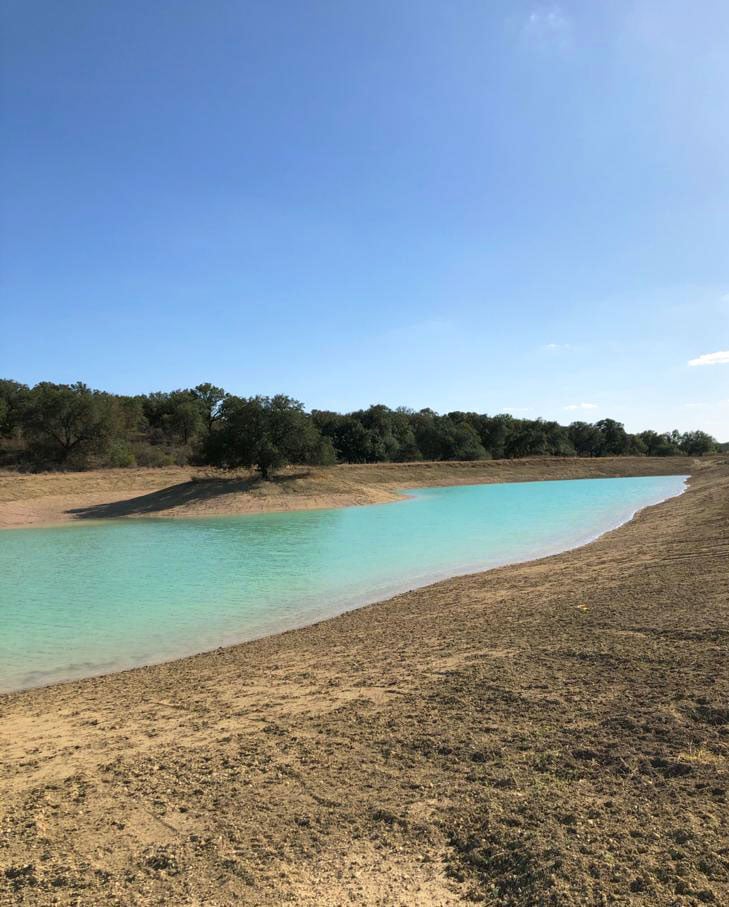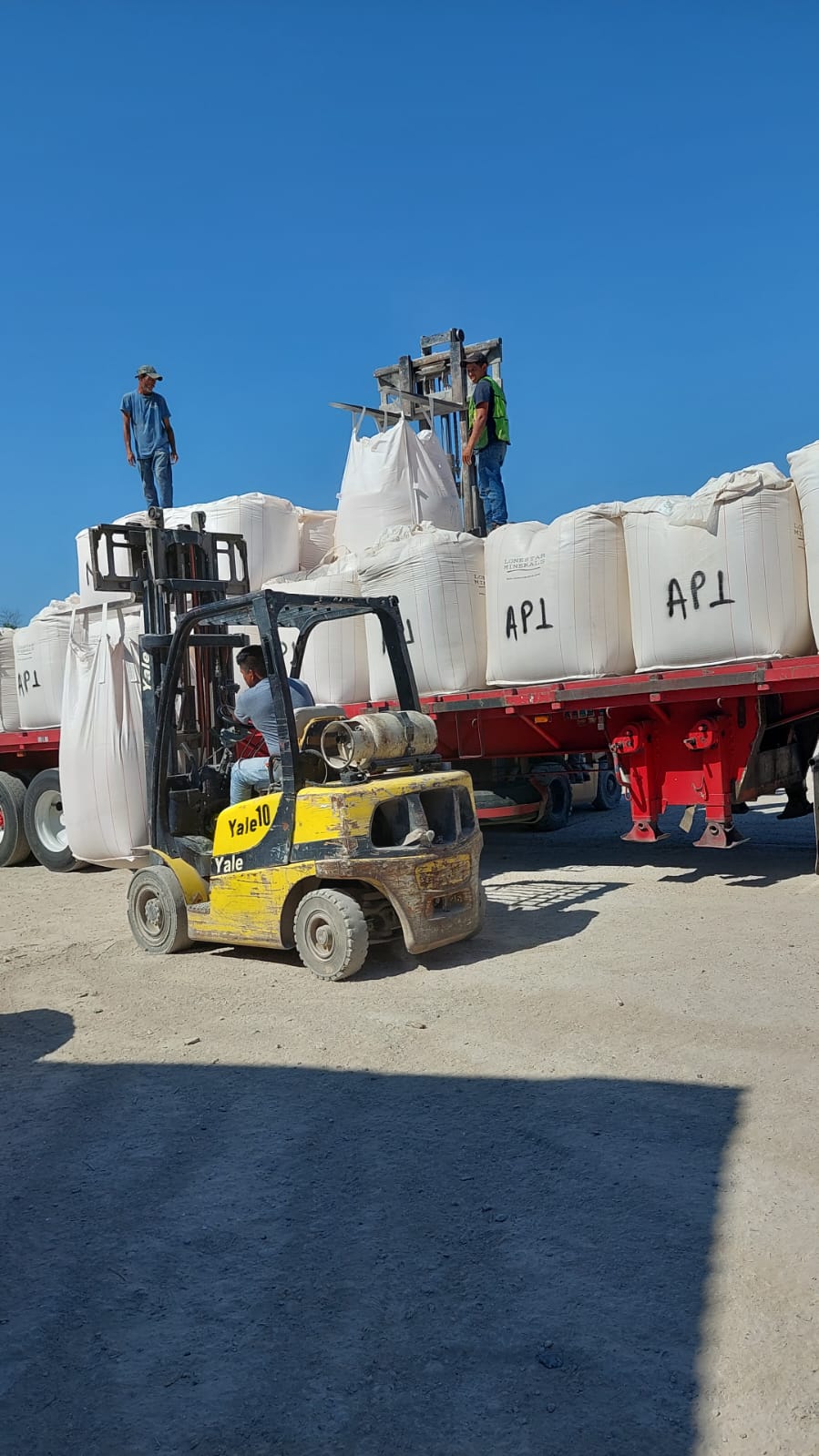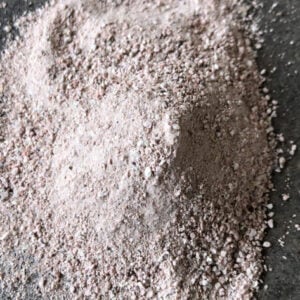The working principle of bentonite pond sealer is simple.
Sodium bentonite absorbs water, expands, and creates a muddy gel that fills holes, pores, and cracks in the soil.
In ponds with water, you can sprinkle the sealant over the water surface, it will sink to the bottom and create the muddy gel layer on top of the pond floor.
In dry ponds, bentonite needs to be mixed and compacted with the pond soil to create a low permeability liner.

How to apply bentonite pond sealer?
There are three methods commonly used to seal a pond with bentonite pond sealer: the blanket method, the blanket mix method, and the sprinkle method. Their use depends on the state of the pond.
For example: In a large pond (2-acre area) with fish, the preferred method will be the sprinkler method. While, in new pond constructions, we will use the blanket or mixed blanket method.
The idea is the same for all three pond sealer application methods: create a thick layer of bentonite that seals holes and pores in the bottom of the pond.
Using the correct method and applying enough bentonite pond sealer is the difference between a full pond for years to come or headaches year after year.
Bentonite Clay Application with pneumatic trailer
Bentonite Advantages
- One of its best advantages is its self-healing property. When mixed with water, Bentonite expands and forms into a gel that will self-seal each time it has a puncture.
- Bentonite Pond Sealer is exceptionally easy to apply. Depending on the condition of your pond, you can either spray it on or use simple farm tools to apply it.
- Sodium Bentonite is a 100% natural mineral. It will not add chemicals to the soil of your pond.
- It is ideal for stock ponds, ponds with fishes and plants, and swimming ponds.
- Sodium bentonite is the most environmentally friendly product in the industry.
- Bentonite is a long-lasting solution. Due to its self-healing and low degradation properties, it will last for many years.
Bentonite can be used by:
-
-
- Farm & Ranch Owners- For retention, fishing and recreational ponds.
- Residential Developments- Retention and recreational ponds are part of residential construction since the 1970’s.
- Municipalities & State Governments- Any requirements for retention, wildlife and fishing ponds can be served.
- Golf Courses- Serving hotels & golf courses all over the country.
- Businesses- Venues for social events can look idyllic all the time.
- Homeowners- Suburban owners build and line their recreational ponds with bentonite.
-
HOW MUCH BENTONITE POND SEALANT DOES A POND NEED?
Not applying enough pond sealant is the most common mistake when sealing a leaking pond or building a new one. The amount of bentonite needed to seal a pond depends on the application method but mainly on the composition of the soil.
The soils with more rock or gravel need more sodium bentonite than those with more clay.
You can find the suggested amount of bentonite pond sealer per square foot in this table.
To get an approximate amount of bentonite pond sealer to seal your pond, you can visit our Bentonite Calculator.
| Type Of Soil | Bentonite required |
|---|---|
| Rock or Gravel | 5 lbs per sqft |
| Sand Soil | 4 lbs per sqft |
| Silt Soil | 3 lbs per sqft |
| Clay Soil | 2 lbs per sqft |
Bentonite Pond Sealer vs Soilfloc
There are two main types of pond sealing products, active and passive pond sealants.
The active pond sealing products are those that interact with the environment to create a tight seal that prevents or repairs leakage.
Sodium bentonite belongs to the active pond sealing products. In the same category, we find polymeric pond sealants such as Soilfloc, which makes them our direct competition. (yes, we respect them, and we are not afraid to talk about them).
Comparing Pond sealer composition
The working principles of Soilfloc and Bentonite pond sealer are different and suit different pond conditions.
Soilfloc is a polymer derived from plants, it works by attracting the clay molecules to each other to create the seal of the pond.
Although both are active pond sealants, their operating principles are different. So each will work best in a given pond condition.
Comparing Pond sealer uses.
Polymers, like soilfloc, are designed to be applied in ponds with water, which means you can’t use them in dry ponds.
Bentonite Pond Sealant performs best in dry ponds, but you can also use it in ponds with water.

Which pond sealer is the best?
It will depend on your project.
If you are having trouble with an unidentified leak in a pond of water, soilfloc will work best.
If the pond is dry or can be drained, bentonite will be the best choice.
There are cases where Bentonite Pond Sealer will be better than Soilfloc in wet applications such as:
- To seal holes dug by rodents.
- To Sealing dams or embankments.
- For identified isolated leaks.
If you are hesitant between these two types of pond sealers, give us a call: 1-800-608-5112. We will honestly tell you if bentonite is not the best choice for your project (yes, integrity is one of our core values).
Where to buy sodium bentonite pond sealer?
You can buy Sodium Bentonite Pond Sealer with us.
Lonestar Minerals offer High quality Sodium Bentonite at Wholesale price, Nationwide Delivery and the best landed price.
Request a quote and we will send it to you in 48 hrs.
If your inquiry is urgent give us a call 1-800-608-5112
Do you need help applying Bentonite Pond Sealer?
We provide full service to fix leaky ponds and lakes. We’ll supply the necessary equipment, operators, and mineral to seal your pond and offer you a turnkey job. Sealing a pond with bentonite is as easy as giving us a call now.



